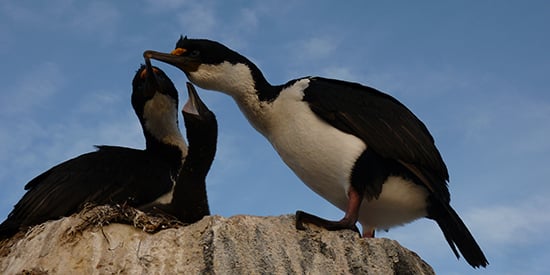Compatibility critical when searching for a subantarctic shag
Media releaseThe old adage that opposites attract doesn't seem to translate to the avian dating scene, or at least not with Kerguelen shags, a subantarctic, diving seabird that has been recently found to breed with a monogamous mate that best matches its feeding habits.
New research from Deakin University and CEBC-CNRS Chize in France - published in the journal Marine Ecology Progress Series today - found the shags typically form breeding pairs with partners that match their foraging behaviour and have similar diets.
Lead researcher Elodie Camprasse, a PhD candidate in Deakin's School of Life and Environmental Sciences, said the team deployed small devices on both members of breeding pairs to record where they went to find food at sea and for how long, and to record how deep they dive and for how long.
"How far a bird can go, how deep a bird can dive and for how long all depends in part on its size and its mass - scientifically known as its 'morphology'," Ms Camprasse said.
"The interesting thing was that these breeding pairs were not similar in morphology, yet they displayed similar behaviours when looking for food.
"Partners dived to more similar depths and in more similar places, compared to birds that were not paired. They also had more similar diets."
Dr Charles Bost, from CEBC-CNRS Chize, said the result was especially amazing as the two partners never foraged at the same time during breeding.
"This could either indicate that birds directly select partners during the courtship that have similar diets and/or behaviours, or develop similarities in behaviour and/or diet as a result of communication to increase their success when looking for food," Dr Bost said.
Kerguelen shags are endemic to the Kerguelen Islands in the Southern Indian Ocean, a group of uninhabited islands in the French Antarctic and Subantarctic Territories, one of the most isolated places on Earth.
The birds nest on top of cliffs and fly to the areas where they dive for food, usually bottom-dwelling fish, squid, worms and crustaceans.
The birds live on the islands year round, and are not threatened as far as researchers know, but Ms Camprasse said very little was actually known about their population trends.
Supervising researcher Professor John Arnould, from Deakin's Centre for Integrative Ecology, said the research into Kerguelen shags was important because similar diets and foraging behaviour between breeding pairs had the potential to increase their reproductive success.
"If animals are able to communicate information about successful strategies to find food to their partners, then the pair will become better at raising their young," Professor Arnould said.
"Looking at these choices or ways to communicate between partners will help determine what makes better parents."
This research was supported by the CSIRO, the University of La Rochelle, the Centre d'Etudes Biologiques de Chize and the French Polar Institute.

